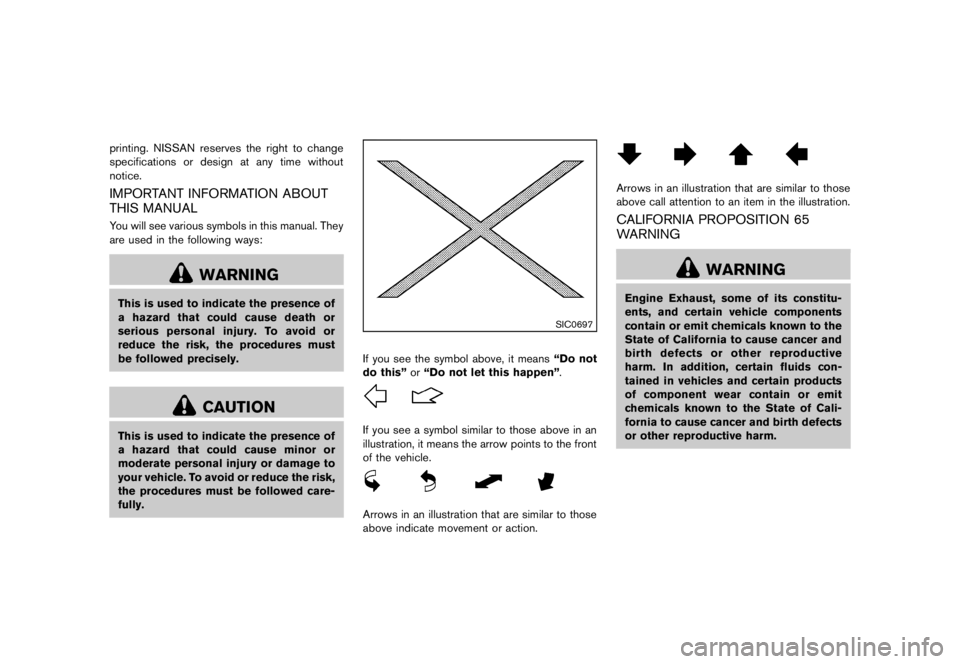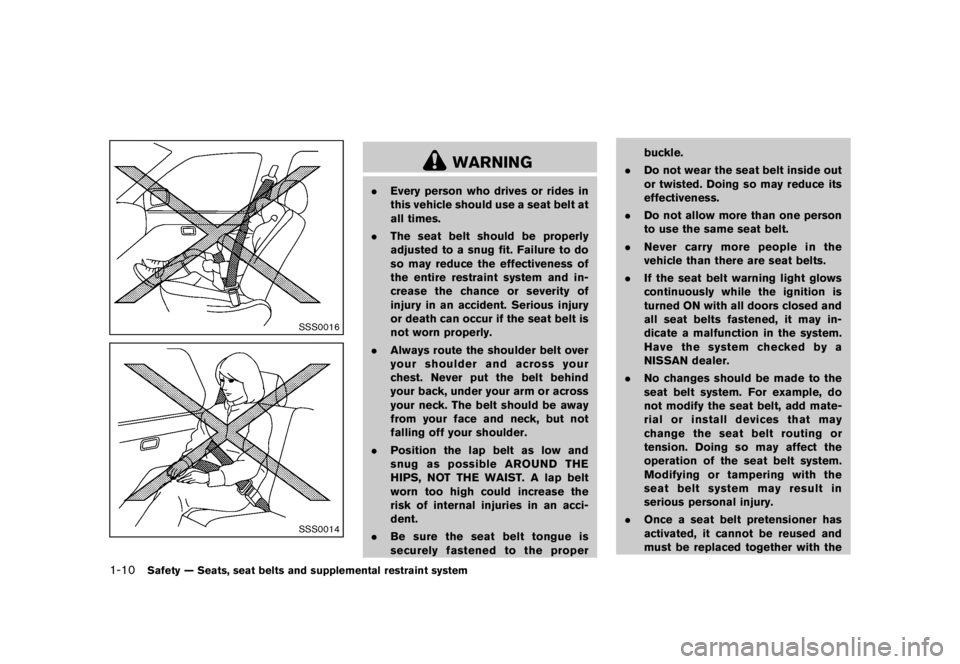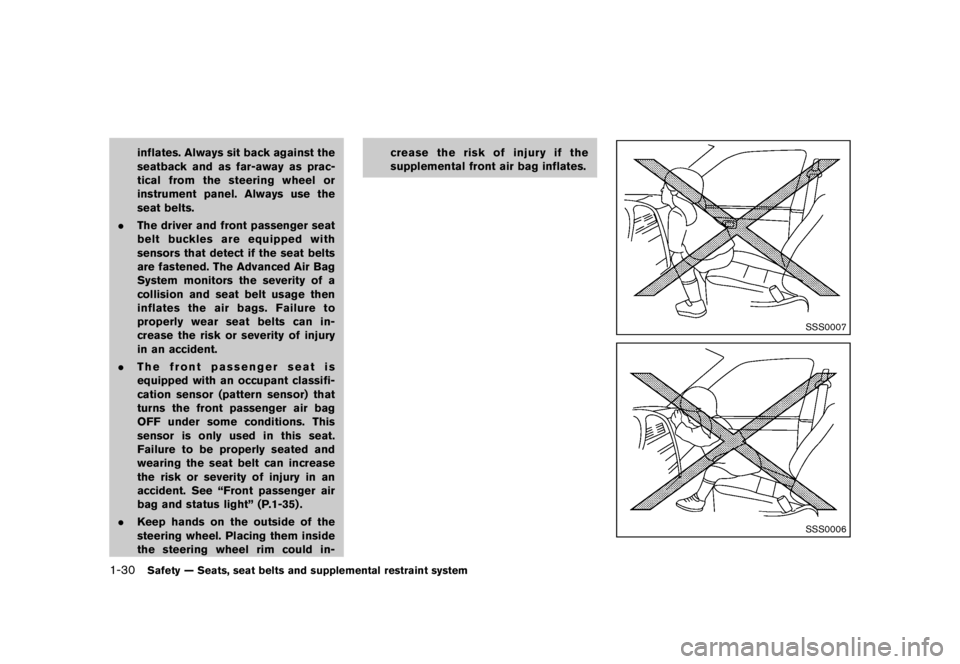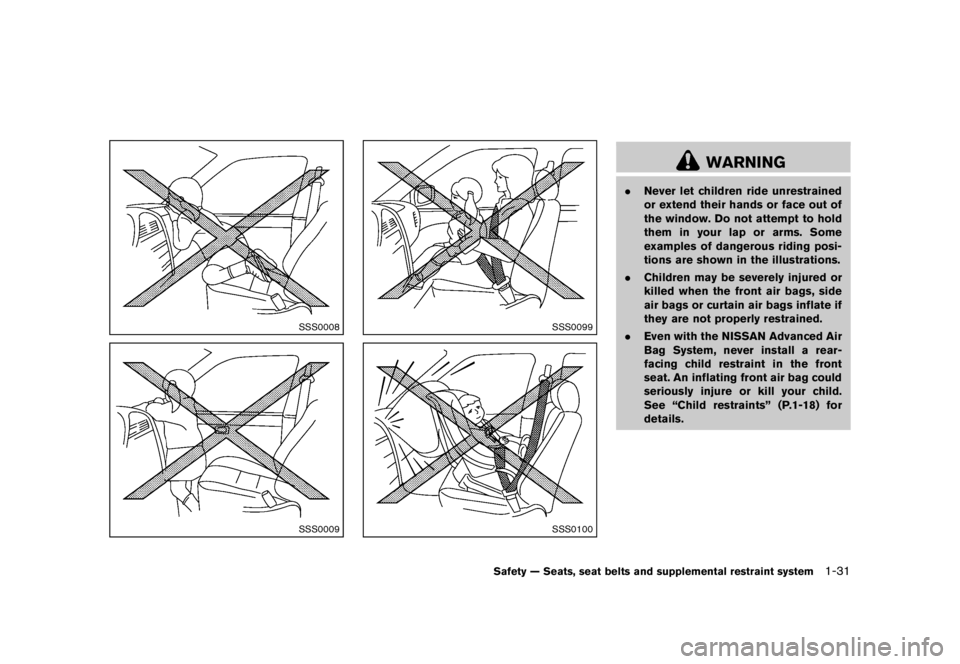2011 NISSAN 370Z tires
[x] Cancel search: tiresPage 3 of 1281

surfaces even with ABS. Stopping
distances may also be longer on
rough, gravel or snow covered
roads, or if you are using tire chains.
Always maintain a safe distance
from the vehicle in front of you.
Ultimately, the driver is responsible
for safety.
. Tire type and condition may also
affect braking effectiveness.
— When replacing tires, install the
specified size of tires on all four
wheels.
— When installing a spare tire, make sure that it is the proper
size and type as specified on the
Tire and Loading Information
label. See “Tire and Loading
Information label” (P.9-13) of
this manual.
— For detailed information, see “Wheels and tires” (P.8-31) of
this manual.
The Anti-lock Braking System (ABS) controls
the brakes so the wheels do not lock during hard
braking or when braking on slippery surfaces.
The system detects the rotation speed at each wheel and varies the brake fluid pressure to
prevent each wheel from locking and sliding. By
preventing each wheel from locking, the system
helps the driver maintain steering control and
helps to minimize swerving and spinning on
slippery surfaces.
Using the systemGUID-5F8F3DF3-1213-44B2-819C-394D031FC9DBDepress the brake pedal and hold it down.
Depress the brake pedal with firm steady
pressure, but do not pump the brakes. The
ABS will operate to prevent the wheels from
locking up. Steer the vehicle to avoid obstacles.
Page 32 of 1281

TirePressure, Low tire pressure warning light ...
..... 2-12
Sealant ...
....................................................................... 6-8
Tire replacement indicator ...
................................. 2-21
Tires Emergency tire puncture repair kit ...
..................... 6-8
Flat tire ...
....................................................................... 6-2
Low tire pressure warning system ...
...................... 5-3
Spare tire ...
................................................................ 8-40
Tire and Loading information label ...
....... 8-32, 9-13
Tire chains ...
.............................................................. 8-37
Tire dressing ...
............................................................. 7-5
Tire pressure ...
......................................................... 8-31
Tire pressure monitoring
system (TPMS) ...
............................................... 5-3, 6-2
Tire rotation ...
............................................................ 8-38
Types of tires ...
......................................................... 8-36
Uniform tire quality grading ...
............................... 9-21
Wheel/tire size ...
......................................................... 9-9
Wheels and tires ...
.................................................. 8-31
Tonneau cover (see cargo cover) ...
........................... 2-43
Top, Soft top ...
................................................................ 3-21
Touch screen ...
.................................................................. 4-4
Towing Flat towing ...
............................................................. 9-21
Tow truck towing ...
.................................................. 6-18
Towing a trailer ...
..................................................... 9-20
TPMS, Tire pressure monitoring system ...
................. 5-3
TPMS, Tire pressure warning system ...
...................... 6-2
Trailer towing ...
................................................................ 9-20
Transceiver, HomeLink
®
Universal Transceiver ...
...................................... 2-50, 2-54
Transmission Automatic transmission fluid (ATF) ...
.................. 8-13
Driving with automatic transmission ...
................ 5-12
Driving with manual transmission ...
..................... 5-16
Transmission selector lever lock release ...
........ 5-16 Transmitter (See remote keyless entry system)
...
.... 3-13
Traveling or registering your vehicle in
another country ...
............................................................ 9-11
Trip computer ...
............................................................... 2-22
Trip odometer ...
............................................................... 2-24
Triple meter ...
..................................................................... 2-8
Trunk Interior trunk lid release ...
...................................... 3-19
Light ...
......................................................................... 2-49
Secondary trunk lid release ...
............................... 3-20
Trunk lid ...
.................................................................. 3-18
Trunk release power cancel switch ...
................. 3-19
Turn signal switch ...
....................................................... 2-35
U
Underbody cleaning ...
..................................................... 7-4
Uniform tire quality grading ...
...................................... 9-21
USB memory operation ...
............................................. 4-61
V
Vanity mirror ...
.................................................................. 3-39
Vanity mirror lights ...
...................................................... 2-48
Variable voltage control system ...
............................... 8-18
Vehicle Dimensions ...
............................................................ 9-10
Identification number (VIN) ...
................................ 9-11
Information and settings (models with
navigation system) ...
.................................................. 4-7
Information display ...
............................................... 2-17
Loading information ...
............................................. 9-18
Recovery (freeing a stuck vehicle) ...
.................. 6-21
Security system ...
.................................................... 2-27
Vehicle dynamic control (VDC) off switch ...
..... 2-39
Vehicle dynamic control (VDC) system ...
.......... 5-28
Ventilators ...
...................................................................... 4-24 Voice command (Bluetooth
®Hands-Free
Phone System) ...
............................................................ 4-94
Voice command (NISSAN voice
recognition system) ...
................................................. 4-106
Voltmeter ...
......................................................................... 2-8
W
Warning
Hazard warning flasher switch ...
.......................... 2-36
Lights ...
....................................................................... 2-10
Tire pressure monitoring
system (TPMS) ...
............................................... 5-3, 6-2
Warning/indicator lights and
audible reminders ...
.................................................... 2-9
Warning labels, Air bag warning labels ...
................. 1-40
Warning light Air bag warning light ...
................................ 1-40, 2-13
Anti-lock braking system (ABS)
warning light ...
.......................................................... 2-10
Brake warning light ...
.............................................. 2-10
Intelligent Key system warning light ...
................ 2-11
Low tire pressure warning light ...
........................ 2-12
Seat belt warning light and chime ...
................... 2-13
Warnings and alerts (vehicle
information display) ...
..................................................... 2-20
Warranty, Emission control system warranty ...
....... 9-22
Washer switch, Windshield wiper and
washer switch ...
.............................................................. 2-30
Washing ...
........................................................................... 7-2
Waxing ...
............................................................................. 7-4
Wheel/tire size ...
............................................................... 9-9
Wheels and tires ...
......................................................... 8-31
Care of wheels ...
........................................................ 7-4
Cleaning aluminum alloy wheels ...
......................... 7-5
Window washer fluid ...
................................................. 8-15
Page 49 of 1281

5. Three-digit code: Date of Manufacture
6. Four numbers represent the week andyear the tire was built. For example, the
numbers 3103 means the 31st week of
2003. If these numbers are missing,
then look on the other sidewall of the
tire.
*3Tire ply composition and material
The number of layers or plies of
rubber-coated fabric in the tire.
Tire manufacturers also must indicate
the materials in the tire, which include
steel, nylon, polyester, and others.
*4Maximum permissible inflation pres-
sure
This number is the greatest amount of
air pressure that should be put in the
tire. Do not exceed the maximum
permissible inflation pressure.
*5Maximum load rating
This number indicates the maximum
load in kilograms and pounds that can
be carried by the tire. When replacing
the tires on the vehicle, always use a
tire that has the same load rating as
the factory installed tire.
*6Term of “tubeless” or “tube type”
Indicates whether the tire requires an
inner tube (“tube type”) or not (“tube-
less”) .
*7The word “radial”
The word “radial” is shown, if the tire
has radial structure.
*8Manufacturer or brand name
Manufacturer or brand name is shown.
Other tire-related terminology:
In addition to the many terms that are
defined throughout this section, Intended
Outboard Sidewall is (1) the sidewall that
contains a whitewall, bears white lettering
or bears manufacturer, brand and/or model
name molding that is higher or deeper than
the same molding on the other sidewall of
the tire, or (2) the outward facing sidewall
of an asymmetrical tire that has a particular
side that must always face outward when
mounted on a vehicle.
TYPES OF TIRESGUID-759580C7-D81B-4D50-9FD2-4567F5D6545E
Page 50 of 1281

All season tiresGUID-B2669784-76C5-43E8-8E16-E7F77F372F57NISSAN specifies all season tires on some
models to provide good performance all year,
including snowy and icy road conditions. All
Season tires are identified by ALL SEASON
and/or M&S (Mud and Snow) on the tire
sidewall. Snow tires have better snow traction
than All Season tires and may be more appro-
priate in some areas.
Summer tiresGUID-F3ED94EB-3952-42A0-831A-DC9822960777NISSAN specifies summer tires on some
models to provide superior performance on dry
roads. Summer tire performance is substantially
reduced in snow and ice. Summer tires do not
have the tire traction rating M&S on the tire
sidewall.
If you plan to operate your vehicle in snowy or
icy conditions, NISSAN recommends the use of
SNOW tires or ALL SEASON tires on all four
wheels.
Snow tiresGUID-4ABDD5F0-221F-4250-B31A-457D3FD59024If snow tires are needed, it is necessary to select
tires equivalent in size and load rating to the
original equipment tires. If you do not, it can
adversely affect the safety and handling of your
vehicle.
Generally, snow tires will have lower speed
ratings than factory equipped tires and may notmatch the potential maximum vehicle speed.
Never exceed the maximum speed rating of the
tire.
If you install snow tires, they must be the same
brand, construction and tread pattern on all four
wheels, and the same sizes as the original tires.
For additional traction on icy roads, studded
tires may be used. However, some U.S. states
and Canadian provinces prohibit their use.
Check local, state and provincial laws before
installing studded tires. Skid and traction cap-
abilities of studded snow tires, on wet or dry
surfaces, may be poorer than that of non-
studded snow tires.
TIRE CHAINSGUID-B7455203-4D74-496B-95E8-37BFF7A69A2B
Page 52 of 1281

.The original tires have built-in
tread wear indicators. When
wear indicators are visible, the
tire(s) should be replaced.
. Tires degrade with age and use.
Have tires, including the spare,
over 6 years old checked by a
qualified technician, because
some tire damage may not be
obvious. Replace the tires as
necessary to prevent tire failure
and possible personal injury.
. Improper service of the spare
tire may result in serious perso-
nal injury. If it is necessary to
repair the spare tire, contact a
NISSAN dealer.
. For additional information re-
garding tires, refer to “Important
Tire Safety Information” (US) or
“Tire Safety Information” (Cana-
da) in the Warranty Information
Booklet.Replacing wheels and tiresGUID-AF03AAD1-31E4-4485-9EC5-14A6E8DD3259When replacing a tire, use the same size, tread
design, speed rating and load carrying capacity
as originally equipped. (See “Specifications”
(P.9-8) for recommended types and sizes of
tires and wheels.)
Page 53 of 1281

Safety Information” (Canada) in the
Warranty Information Booklet.
Wheel balanceGUID-473AE29D-90D3-4BFC-A1BC-2ECEFFDDB2A5Unbalanced wheels may affect vehicle handling
and tire life. Even with regular use, wheels can
get out of balance. Therefore, they should be
balanced as required.
Wheel balance service should be per-
formed with the wheels off the vehicle.
Spin balancing the wheels on the vehicle
could lead to mechanical damage.
For additional information regarding tires, refer
to “Important Tire Safety Information” (US) or
“Tire Safety Information” (Canada) in the
NISSAN Warranty Information Booklet.
Care of wheelsGUID-AE17AEB8-FABA-4861-929E-542E27F4C349See “Cleaning exterior” (P.7-2) for details about
care of the wheels.
Spare tire (TEMPORARY USE ONLY (T-
type) spare tire) (if so equipped)
GUID-03C54C91-D948-4596-A82A-832287E21DAFObserve the following precautions if the T-type
spare tire must be used, otherwise your vehicle
could be damaged or involved in an accident.
Page 88 of 1281

surfaces even with ABS. Stopping
distances may also be longer on
rough, gravel or snow covered
roads, or if you are using tire chains.
Always maintain a safe distance
from the vehicle in front of you.
Ultimately, the driver is responsible
for safety.
. Tire type and condition may also
affect braking effectiveness.
— When replacing tires, install the
specified size of tires on all four
wheels.
— When installing a spare tire, make sure that it is the proper
size and type as specified on the
Tire and Loading Information
label. See “Tire and Loading
Information label” (P.9-13) of
this manual.
— For detailed information, see “Wheels and tires” (P.8-31) of
this manual.
The Anti-lock Braking System (ABS) controls
the brakes so the wheels do not lock during hard
braking or when braking on slippery surfaces.
The system detects the rotation speed at each wheel and varies the brake fluid pressure to
prevent each wheel from locking and sliding. By
preventing each wheel from locking, the system
helps the driver maintain steering control and
helps to minimize swerving and spinning on
slippery surfaces.
Using the systemGUID-5F8F3DF3-1213-44B2-819C-394D031FC9DBDepress the brake pedal and hold it down.
Depress the brake pedal with firm steady
pressure, but do not pump the brakes. The
ABS will operate to prevent the wheels from
locking up. Steer the vehicle to avoid obstacles.
Page 115 of 1281

.Always pull the cable straight out
from the front of the vehicle. Never
pull on the vehicle at an angle.
. Pulling devices should be routed so
they do not touch any part of the
suspension, steering, brake or cool-
ing systems.
. Pulling devices such as ropes or
canvas straps are not recommended
for use in vehicle towing or recov-
ery.
Rocking a stuck vehicleGUID-1F515541-8096-42B5-BC89-49A51BF43A3CIf your vehicle is stuck in sand, snow, mud, etc.,
use the following procedure:
1. Turn off the Vehicle Dynamic Control (VDC)
system.
2. Make sure the area in front and behind the vehicle is clear of obstructions.
3. Turn the steering wheel right and left to clear an area around the front tires.
4. Slowly rock the vehicle forward and back- ward.
.Shift back and forth between R (Reverse)
and D (Drive) (automatic transmission
models) or 1st and R (Reverse) (manual
transmission models) .
.Apply the accelerator as little as possibleto maintain the rocking motion.
.Release the accelerator pedal beforeshifting between R (Reverse) and D
(Drive) (automatic transmission models)
or 1st and R (Reverse) (manual transmis-
sion models) .
.Do not spin the tires above 35 MPH (55 km/h).
5. If the vehicle cannot be freed after a few tries, contact a professional towing service
to remove the vehicle.